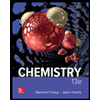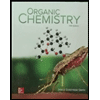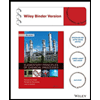
Concept explainers
(a)
Interpretation:
Concept introduction:
The standard enthalpy of reaction is calculated by the summation of standard enthalpy of formation of the product minus the summation of standard enthalpy of formation of product at the standard conditions. The formula to calculate the standard enthalpy of reaction
Here, m and n are the
(b)
Interpretation:
The combustion reaction for ethanol is to be written. Whether sugar or ethanol has higher value heat of combustion per mole of
Concept introduction:
The standard enthalpy of reaction is calculated by the summation of standard enthalpy of formation of the product minus the summation of standard enthalpy of formation of product at the standard conditions. The formula to calculate the standard enthalpy of reaction
Here, m and n are the stoichiometric coefficients of reactants and product in the balanced chemical equation.
Want to see the full answer?
Check out a sample textbook solution
Chapter 6 Solutions
CHEMISTRY: MOLECULAR...(LLF) W/CONNECT
- Propose Williamson ether syntheses for the following compoundsarrow_forwardIdentify all functional groupsarrow_forwardA mixture of CaCO3 and MgC2O4 of unknown mass was heated in a 0.5 L closed rigid vessel to 900 degrees C.at 400C the following reaction occurs:MgC2O4 -> MgO (s) + CO (g) + CO2 (g)At 700C a second reaction occurs: CaCO3 -> CaO (s) + CO2 (g)The solid mass in the vessel was measured to be 3.06 g at 400C and 2.03g at 900CQuestion: What is the partial pressure of CO in both temperatures? (400 and 900C), provide detailed explanation.arrow_forward
- For the following alkyne, complete the reaction sequentially (that is draw the intermediate that we can’t stop at) and then name (complete name) all 3 molecules.arrow_forwardGiven the reaction sequence below, answer the following. A. Provide the structure for A. B. Provide the structure for B (pay attention to stereochemistry). C. Provide the structure for C. D. What are the stereochemical designations for I and II (R/S)?arrow_forwardWhich of the following is the most stable carbon radical?arrow_forward
- Put the following carbon radicals in order of increasing stability.arrow_forwardDraw the major organic product for each of the following reactions (pay attention to stereochemistry).arrow_forwardThere are 2 reactions (that you know of) to achieve the following transformation: One reaction is favored over the other because it avoids a competing reaction. A. Draw the favored reaction scheme (not the mechanism), be sure to include all necessary reagents. B. Draw the reaction scheme that is not favored and include all the possible products.arrow_forward
- Both carbocations and carbon-radicals have trigonal planar geometry. True or Falsearrow_forwardTeflon (polytetrafluoroethene) is prepared via the radial polymerization of tetrafluoroethene. What other reaction conditions (reagent, etc.) are needed to accomplish this? A. NBS, Light B. Heat, Cl2 C. Peroxide, Heat D. H2SO4, H2O, Heatarrow_forwardWhich of the following compounds can be reacted with ethene to prepare 1,1- dichlorocyclopropane? A. CCl4 B. CCl2 C. CHCl3 D. CH2Cl2arrow_forward
 ChemistryChemistryISBN:9781305957404Author:Steven S. Zumdahl, Susan A. Zumdahl, Donald J. DeCostePublisher:Cengage Learning
ChemistryChemistryISBN:9781305957404Author:Steven S. Zumdahl, Susan A. Zumdahl, Donald J. DeCostePublisher:Cengage Learning ChemistryChemistryISBN:9781259911156Author:Raymond Chang Dr., Jason Overby ProfessorPublisher:McGraw-Hill Education
ChemistryChemistryISBN:9781259911156Author:Raymond Chang Dr., Jason Overby ProfessorPublisher:McGraw-Hill Education Principles of Instrumental AnalysisChemistryISBN:9781305577213Author:Douglas A. Skoog, F. James Holler, Stanley R. CrouchPublisher:Cengage Learning
Principles of Instrumental AnalysisChemistryISBN:9781305577213Author:Douglas A. Skoog, F. James Holler, Stanley R. CrouchPublisher:Cengage Learning Organic ChemistryChemistryISBN:9780078021558Author:Janice Gorzynski Smith Dr.Publisher:McGraw-Hill Education
Organic ChemistryChemistryISBN:9780078021558Author:Janice Gorzynski Smith Dr.Publisher:McGraw-Hill Education Chemistry: Principles and ReactionsChemistryISBN:9781305079373Author:William L. Masterton, Cecile N. HurleyPublisher:Cengage Learning
Chemistry: Principles and ReactionsChemistryISBN:9781305079373Author:William L. Masterton, Cecile N. HurleyPublisher:Cengage Learning Elementary Principles of Chemical Processes, Bind...ChemistryISBN:9781118431221Author:Richard M. Felder, Ronald W. Rousseau, Lisa G. BullardPublisher:WILEY
Elementary Principles of Chemical Processes, Bind...ChemistryISBN:9781118431221Author:Richard M. Felder, Ronald W. Rousseau, Lisa G. BullardPublisher:WILEY





